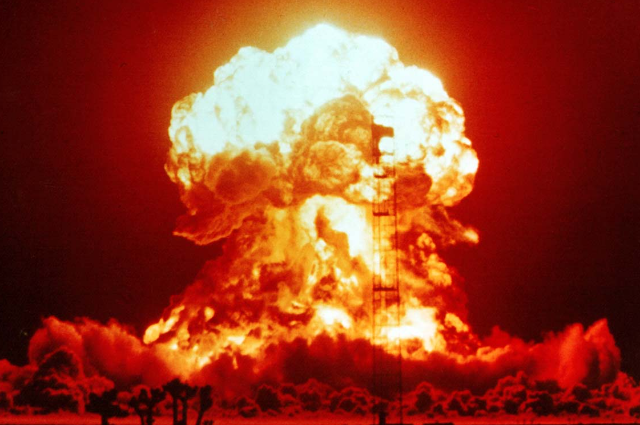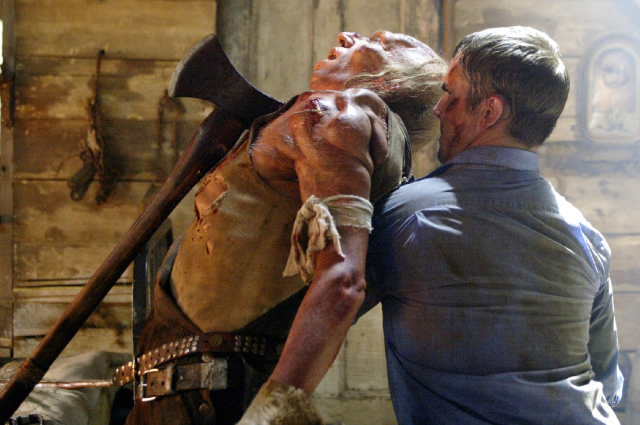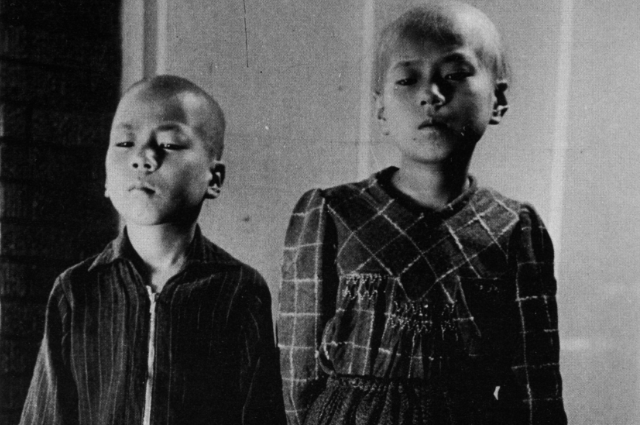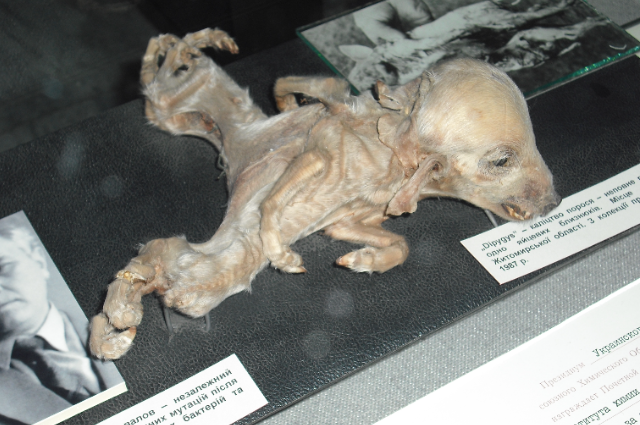Introduction:
The Intersection of Horror, Science, and Reality
Humanity has always been fascinated by the extraordinary—whether through myth, science fiction, or real-life anomalies that defy conventional understanding. From ancient legends of monstrous beings to modern horror films like Wrong Turn, the idea of mutation has captivated our collective imagination. But while fiction tends to exaggerate or distort reality for dramatic effect, the truth behind genetic mutations—especially those caused by radiation—is far more harrowing than any Hollywood depiction.
One of the most terrifying real-world examples of mutation comes from the atomic bombings of Hiroshima and Nagasaki in 1945. These events did not create monstrous figures lurking in the woods but led to an equally horrifying legacy: a surge in birth defects, cancer, and genetic disorders among survivors and their descendants. The impact of radiation on human DNA has been studied extensively, revealing how exposure to nuclear fallout can alter genetic material in ways that persist across generations.
At the same time, genetic mutations occur naturally in humans, leading to rare and sometimes astonishing conditions. Cases like sirenomelia (mermaid syndrome), gigantism, and neurofibromatosis challenge our perception of normalcy, blurring the line between scientific reality and the fantastical. While some mutations result in debilitating conditions, others can give rise to extraordinary abilities, such as enhanced memory or superior color perception.
Beyond human biology, mutations in nature can have profound consequences. The hypothetical emergence of a mermaid-like species or genetically altered marine life could disrupt the delicate balance of ocean ecosystems, affecting predator-prey relationships and the food chain. Evolution, whether natural or artificially induced, is a double-edged sword—it can lead to incredible advancements or catastrophic disruptions.
This article explores the dark reality of atomic mutation, the mysteries of real-life genetic anomalies, and the speculative impact of mutations on ecosystems. By bridging the gap between history, science, and fiction, we aim to shed light on the unintended consequences of genetic alterations—both natural and human-made. As we venture into an era where genetic engineering is becoming a reality, it is crucial to reflect on past mistakes and ethical dilemmas to ensure that science does not become a source of future horror.
Through this deep dive into atomic mutations, rare human conditions, and the potential consequences of environmental disruptions, we will unravel the complex and often unsettling truth about how mutations shape the world around us.
The fascination with mutation, both in fiction and reality, has long captured human imagination. From horror films like Wrong Turn, which depict grotesque, radiation-induced mutations, to real-life genetic anomalies such as the “Mermaid of Sindh” and the survivors of Hiroshima and Nagasaki, the theme of mutation has deep roots in history, science, and storytelling. But how much of what we see in entertainment is rooted in reality? This article explores the grim consequences of atomic mutation, real-life genetic conditions, and the impact of human mutations on the natural order.
The Reality Behind Wrong Turn: A Fictional Horror with a Real Tragedy
The 2003 horror film Wrong Turn horrified audiences with its depiction of inbred, deformed cannibals living in isolation. While exaggerated for cinematic effect, the idea of human mutation due to radiation exposure is not purely fictional. The true horror of radiation-induced mutations dates back to one of the darkest events in human history—the atomic bombings of Hiroshima and Nagasaki.
When Fiction Mirrors Reality
Horror films often take inspiration from real-life events, amplifying them into nightmarish scenarios for cinematic effect. The 2003 film Wrong Turn is no exception. The movie, which depicts a group of travelers being hunted by inbred, cannibalistic mutants in the wilderness, taps into our deepest fears of isolation, deformity, and genetic aberrations. While the film’s portrayal is exaggerated, its core concept—humans suffering from severe mutations due to environmental and genetic factors—has roots in real scientific and historical tragedies.
One of the most devastating real-world examples of human mutation stems from nuclear warfare, particularly the atomic bombings of Hiroshima and Nagasaki in 1945. The long-term consequences of radiation exposure among survivors—known as hibakusha—included severe birth defects, increased cancer rates, and genetic abnormalities that lasted for generations. In addition, other instances of radiation exposure, such as nuclear testing in the Pacific and the Chernobyl disaster, have revealed how radiation can permanently alter human DNA.
This article explores the intersection of fiction and reality by examining the Wrong Turn mythology alongside the scientifically documented effects of radiation on human genetics. We will uncover how nuclear disasters, genetic mutations, and the horrors of scientific negligence have created real-life tragedies that rival even the most terrifying Hollywood horror stories.
The Atomic Bombings of Hiroshima and Nagasaki: A Defining Moment in Human Mutation
The atomic bombings of Hiroshima (August 6, 1945) and Nagasaki (August 9, 1945) marked the first and only time nuclear weapons were used in warfare. The immediate impact was catastrophic—an estimated 140,000 people in Hiroshima and 70,000 in Nagasaki died within months. However, the true horror unfolded in the following decades as radiation exposure left a haunting legacy of genetic mutations.
1. Radiation and Its Genetic Impact
Ionizing radiation, such as that released by atomic bombs, damages DNA in several ways:
- Single-strand and double-strand DNA breaks: Radiation can sever DNA strands, leading to mutations when the body attempts to repair them incorrectly.
- Chromosomal aberrations: Survivors of Hiroshima and Nagasaki exhibited an increased frequency of chromosomal abnormalities, including deletions, translocations, and inversions.
- Epigenetic changes: Radiation exposure can alter gene expression without changing the DNA sequence itself, affecting future generations.
The results were devastating. Over time, studies conducted by the Radiation Effects Research Foundation (RERF) found that survivors and their children experienced increased rates of birth defects, cancers, and other health issues.
2. Birth Defects and Congenital Abnormalities
Children born to hibakusha parents exhibited a significantly higher risk of congenital disorders, including:
- Microcephaly (abnormally small head size)
- Cleft palate and other craniofacial abnormalities
- Limb deformities and missing fingers or toes
- Neurological disorders leading to intellectual disabilities
Many of these mutations were eerily similar to the grotesque deformities depicted in Wrong Turn, where the antagonists suffer from extreme genetic abnormalities due to prolonged inbreeding and environmental exposure.
3. Cancer and Radiation-Related Diseases
Radiation exposure increased the likelihood of several cancers among the survivors and their descendants:
- Leukemia was one of the most common radiation-induced cancers, appearing at higher rates in survivors within a decade of exposure.
- Thyroid cancer, breast cancer, and lung cancer rates were significantly elevated.
- Non-cancerous disorders, such as cataracts and cardiovascular diseases, were also prevalent among survivors.
The Wrong Turn franchise may not explicitly reference nuclear exposure, but its core premise—severe genetic mutations passed down through generations—mirrors the scientific findings on radiation-induced genetic disorders.
The Broader History of Radiation-Induced Mutations
While Hiroshima and Nagasaki serve as the most well-documented examples of human genetic damage due to radiation, they are far from the only cases. Other nuclear disasters and experiments have resulted in similar consequences:
1. Chernobyl (1986): The Birth of Mutants
The Chernobyl disaster exposed millions of people to high levels of radiation. The effects included:
- A drastic increase in thyroid cancer, particularly in children.
- Birth defects such as spina bifida (spinal cord malformation) and anencephaly (absence of a major portion of the brain).
- Mutations observed in animals, including deformities in birds, fish, and mammals.
The long-term impact of Chernobyl has fueled speculation about whether prolonged radiation exposure could create a scenario akin to Wrong Turn, where humans in isolated areas develop extreme genetic anomalies.
2. Nuclear Testing in the Pacific: The Forgotten Victims
Between 1946 and 1958, the U.S. conducted extensive nuclear tests in the Marshall Islands. The indigenous population was exposed to radiation levels comparable to those in Hiroshima. Effects included:
- High rates of miscarriage and stillbirths.
- Severe physical deformities in newborns.
- Increased cancer rates in later generations.
These real-world cases further support the idea that prolonged radiation exposure can lead to severe human mutations, much like those seen in fictional horror films.
The Psychological Horror of Mutation
One of the most terrifying aspects of Wrong Turn is not just the physical mutations of its antagonists, but the psychological implications of their condition. Survivors of real-world radiation disasters also suffer from immense psychological trauma:
- Social stigma and discrimination: Many hibakusha were ostracized due to fears that their condition was contagious.
- Survivor’s guilt: Many individuals who survived nuclear attacks struggled with the psychological burden of witnessing the deaths of loved ones.
- Post-Traumatic Stress Disorder (PTSD): The horror of living with an unpredictable health condition left many survivors in perpetual fear.
These psychological effects highlight the real horror behind Wrong Turn. The fear of isolation, deformity, and being treated as an outcast is not just a fictional trope—it is a reality for many nuclear disaster survivors.
The Real Horror Behind Wrong Turn
While Wrong Turn is a work of fiction, its themes resonate deeply with real-world events. The grotesque, inbred mutants of the film might be exaggerated, but they serve as a chilling reminder of what unchecked environmental and genetic degradation can lead to.
The atomic bombings of Hiroshima and Nagasaki, the Chernobyl disaster, and other nuclear experiments have shown us that radiation-induced mutations are not mere science fiction. They are a documented reality with long-lasting consequences.As humanity continues to explore nuclear energy and genetic modification, we must remember the lessons of the past. The tragedies of radiation-induced mutations serve as stark warnings about the dangers of nuclear warfare and environmental negligence.
In the end, the true horror is not the fictional monsters lurking in the woods, but the real-life consequences of scientific recklessness—where the wrong turn leads not to a cinematic scare but to generational suffering.
The Atomic Bombings: A Catastrophe Beyond Imagination
On August 6 and 9, 1945, the United States dropped atomic bombs on Hiroshima and Nagasaki, instantly killing tens of thousands and exposing countless others to deadly radiation. The long-term effects were far more insidious—many survivors, known as hibakusha, suffered from devastating health conditions, including:
- Severe Burns and Radiation Sickness – Skin peeling off, internal bleeding, and organ failure were immediate effects.
- Genetic Mutations – Survivors and their offspring experienced birth defects, developmental disorders, and an increased risk of cancer.
- Psychological Trauma – Many hibakusha suffered from PTSD, depression, and social stigma, further compounding their suffering.
Radiation-Induced Mutations: Science Behind the Horror
- Radiation damages DNA by altering its structure, causing mutations that can persist for generations. The genetic effects of radiation exposure observed in Hiroshima and Nagasaki survivors include:
- Birth Defects: Increased cases of microcephaly (small head size), missing limbs, and cleft palates.
- Cancer Risks: Survivors exhibited higher rates of leukemia and thyroid cancer.
- Chromosomal Abnormalities: Studies showed DNA damage could be passed down, affecting future generations.
While Wrong Turn sensationalizes the concept of radiation-induced mutations, its inspiration may lie in the real horrors faced by atomic bomb survivors, who endured physical and genetic suffering beyond imagination.
The Forgotten Fallout: Real-Life Cases of Human Mutation
Human mutation is not always the result of nuclear exposure; some mutations occur naturally, leading to extraordinary conditions that challenge our understanding of biology.
The “Mermaid” of Sindh: A Rare Genetic Disorder
In 2007, a baby girl named Shilpa was born in Pakistan with sirenomelia, commonly known as “Mermaid Syndrome.” This rare disorder causes the legs to fuse together, resembling a mermaid’s tail. While a rare occurrence, it raises questions about genetic mutations and environmental factors influencing birth defects.
The Giant Among Men: Robert Wadlow
Robert Wadlow, the tallest man in recorded history, reached 8 feet 11 inches due to pituitary gigantism, a condition caused by excessive growth hormone production. Though he became a global sensation, his life was plagued by health complications. His case illustrates how hormonal imbalances can lead to extreme physical changes.
The “Elephant Man”: A Story of Strength
Joseph Merrick, known as the “Elephant Man,” suffered from neurofibromatosis, a disorder that caused extreme physical deformities. Despite societal rejection, Merrick’s intelligence and resilience challenged the perception of beauty and normalcy.
Other Extraordinary Cases of Human Mutation
- Tetrachromacy – Some people possess an extra type of cone in their eyes, allowing them to see millions of colors the average person cannot.
- Hyperthymesia – Individuals with this condition can remember every day of their lives in vivid detail, making them living archives of history.
- Ehlers-Danlos Syndrome – This disorder affects connective tissues, giving individuals hyper-flexible joints and stretchy skin.
These cases highlight the diversity of genetic mutations, proving that not all mutations are harmful—some provide unique abilities and perspectives on human biology.
The Forgotten Fallout: Real-Life Cases of Human Mutation
Introduction: The Hidden Costs of Radiation Exposure
Mutations have always been a part of evolution, shaping the genetic diversity of all living beings. However, when mutations occur due to unnatural causes—such as radiation exposure from nuclear disasters—the consequences can be devastating. The human body is extremely sensitive to ionizing radiation, and when exposed in large doses, the effects can be permanent, causing severe birth defects, cancers, and genetic disorders that persist for generations.
Throughout history, several nuclear disasters and experiments have resulted in horrifying cases of human mutation. From Hiroshima and Nagasaki to Chernobyl and nuclear testing in remote Pacific islands, countless people have suffered the consequences of radiation-induced genetic abnormalities. These real-life cases serve as chilling reminders of the hidden dangers of nuclear fallout.
1. Hiroshima and Nagasaki: The Legacy of Atomic Mutation
The Initial Impact
On August 6 and 9, 1945, the United States dropped atomic bombs on the Japanese cities of Hiroshima and Nagasaki. The immediate blast killed over 200,000 people, but the real horror unfolded in the following years as survivors (hibakusha) experienced severe radiation-related illnesses.
Radiation-Induced Mutations and Birth Defects
Radiation exposure damaged the DNA of the survivors, leading to genetic mutations that persisted in their offspring. Some of the most devastating effects included:
- Microcephaly: Babies born with abnormally small heads and underdeveloped brains.
- Cleft Palate and Facial Deformities: Many children had facial abnormalities and missing facial bones.
- Limb Malformations: Babies were born with missing or deformed limbs.
- Cancer and Leukemia: Survivors experienced a 46% higher chance of developing leukemia.
Case Study:
A survivor named Sadako Sasaki, exposed to radiation at age two, later developed leukemia as a teenager. She became famous for folding 1,000 paper cranes in hopes of recovering, but she died at age 12. Her story is a powerful reminder of the lasting effects of atomic radiation.
2. Chernobyl Disaster: The Birth of Mutants
The Catastrophic Explosion
On April 26, 1986, the Chernobyl nuclear reactor in present-day Ukraine exploded, releasing 400 times more radiation than the Hiroshima bomb. The fallout spread across Europe, but those in nearby Pripyat and Belarus were the most affected.
Chernobyl Children: Radiation-Induced Birth Defects
The most tragic victims of the Chernobyl disaster were the children born after the explosion. Radiation exposure in the womb led to:
- Hydrocephalus: Babies were born with enlarged skulls filled with excess fluid.
- Polydactyly: Some children had extra fingers or toes due to genetic mutations.
- Neural Tube Defects: Many babies were born with exposed spinal cords, leading to paralysis.
- Thyroid Cancer Epidemic: Thousands of children developed thyroid cancer due to contaminated milk from radioactive iodine.
Case Study:
In Belarus, a girl named Maria was born without a left leg and with fused fingers. Doctors linked her condition directly to radiation exposure. She became one of many "Chernobyl Children" adopted by foreign families due to severe health issues.
Chernobyl's Animal Mutations
- Wolves and boars in the Exclusion Zone show genetic anomalies.
- Some birds have smaller brains due to radiation exposure.
- A species of radioactive fungi thrives inside the reactor, feeding on radiation.
3. The Nuclear Testing Horror: Forgotten Victims of Radiation
Marshall Islands (1946-1958): The Pacific’s “Nuclear Graveyard”
Between 1946 and 1958, the U.S. conducted 67 nuclear tests in the Marshall Islands, with some explosions being 1,000 times more powerful than the Hiroshima bomb. The indigenous population was exposed to massive radiation doses.
Effects on the Population
- Severe Birth Defects: Babies were born with missing limbs, extra fingers, and abnormal facial structures.
- High Infant Mortality: Many newborns died within days.
- Stillbirths and Miscarriages: Many women suffered repeated pregnancy losses.
- “Jellyfish Babies”: A term used by local women to describe babies born without bones or with translucent skin.
Case Study:
In 1972, a woman from the Rongelap Atoll gave birth to a baby without eyes, a nose, or a recognizable face. She was one of many victims of nuclear testing.
4. The Semipalatinsk Test Site: The Soviet Union’s Deadly Secret
The Soviet Nuclear Experiments
From 1949 to 1989, the Soviet Union tested over 450 nuclear weapons in Semipalatinsk, Kazakhstan. Villagers nearby were never warned, and generations suffered genetic damage.
Long-Term Consequences
- Three-headed babies: Some children were born with multiple heads due to extreme mutations.
- Extreme Cancers: The region has one of the highest cancer rates in the world.
- Mental Disabilities: Increased cases of autism and developmental disorders.
Case Study:
A boy named Sergei, born in 1985, had a severe spinal deformity, making him unable to walk. His mother lived in Semipalatinsk during the peak of nuclear tests.
5. The Fukushima Nuclear Disaster (2011): A Modern-Day Fallout
The Explosion and Radiation Leak
In 2011, a tsunami caused meltdowns at the Fukushima Daiichi nuclear plant in Japan, releasing large amounts of radiation.
Health Impacts
- Thyroid Cancer Surge: More than 200 cases of thyroid cancer have been reported among children.
- Genetic Mutations in Butterflies: Scientists found Fukushima butterflies with deformed wings, missing legs, and abnormal eyes—signs of radiation-induced genetic mutations.
Conclusion: The Silent Horror of Radiation-Induced Mutations
Throughout history, nuclear disasters and tests have left a tragic legacy of human suffering. While horror films like Wrong Turn depict extreme mutations as fictional nightmares, the reality is that nuclear radiation has caused grotesque and heartbreaking mutations in real life. From the hibakusha of Hiroshima to the children of Chernobyl and the Marshall Islands, countless innocent people have endured genetic abnormalities due to human negligence and political recklessness.
As nuclear technology continues to advance, these real-life horror stories remind us of the catastrophic consequences of radiation exposure. The forgotten fallout of nuclear disasters must never be ignored, for history has shown that the worst mutations do not come from fiction—but from reality itself.
When Nature Mutates: The Ocean’s Unknown and the Food Chain Crisis
While genetic mutations can lead to remarkable human anomalies, what if a mutation occurred in marine life? The concept of a “mermaid-like” species, whether natural or genetically engineered, raises questions about its impact on the ecosystem.
Disrupting the Food Chain
If a humanoid marine species existed with high intelligence and advanced hunting skills, it could disrupt the balance of oceanic ecosystems. Key concerns include:
Predatory Dominance – Would a mermaid-like species outcompete sharks and whales for food?
- Overfishing and Resource Scarcity – A new apex predator could lead to the depletion of certain fish populations, affecting marine biodiversity.
- Environmental Consequences – Would such creatures introduce new diseases or disrupt migration patterns of existing species?
- These speculative scenarios demonstrate how even minor mutations in a species can have ripple effects, impacting the natural world in unforeseen ways.
When Nature Mutates: The Ocean’s Unknown and the Food Chain Crisis
The Silent Transformations of Marine Life
The ocean, covering more than 70% of the Earth’s surface, is a vast and mysterious world teeming with life. However, beneath the waves, unseen forces are triggering alarming changes. Pollution, climate change, and radiation exposure are leading to mutations in marine species, disrupting ecosystems, and creating a ripple effect throughout the food chain. These mutations, often invisible to the human eye, can alter entire populations of marine life, threatening biodiversity and human food security.
From radioactive contamination in the Pacific to plastic-induced genetic changes in deep-sea creatures, nature is mutating in response to human activities. The consequences of these mutations could lead to unforeseen ecological disasters, affecting everything from microscopic plankton to the largest ocean predators.
1. The Impact of Radiation: Chernobyl of the Seas
The Fukushima Disaster and Its Aftermath
In 2011, the Fukushima Daiichi nuclear disaster released over 300 tons of radioactive water into the Pacific Ocean. Scientists later discovered that the radiation had entered the marine food chain, leading to mutations in fish and other sea life.
Real-Life Examples of Radiation-Induced Mutations
- Two-Headed Fish: Fishermen near Fukushima have reported catching fish with two heads, a common mutation linked to radiation exposure.
- Giant Mutant Crabs: Japanese spider crabs, known for their long legs, have been found with disproportionate growth and missing limbs.
- Glowing Tuna: Some radioactive isotopes like cesium-137 have been detected in tuna caught off the coast of California, proving that the radiation spread thousands of miles across the Pacific.
Consequences for the Food Chain
Predators consuming mutated fish may suffer from bioaccumulation of radiation, affecting their health and reproductive success.Humans who consume contaminated seafood may face long-term health risks, including cancer and genetic damage.
2. Plastic Pollution: A Trigger for Genetic Changes
Microplastics and Their Silent Invasion
Over 14 million tons of plastic end up in the ocean every year, breaking down into tiny particles called microplastics. These particles are consumed by marine life, leading to genetic mutations over time.
Real-Life Examples of Plastic-Induced Mutations
- Shrinking Fish Populations: Studies show that fish exposed to microplastics develop smaller reproductive organs, reducing their ability to reproduce.
- Deformed Shellfish: Mussels and oysters have been found with misshapen shells and weakened immune systems due to plastic pollution.
- Gender-Bending Marine Life: Chemicals from plastics can mimic hormones, leading to gender mutations in fish. In some cases, male fish have developed female reproductive organs.
Consequences for the Food Chain
Plankton, the foundation of the marine food web, ingest microplastics, which then travel up the food chain.Predatory species like sharks and dolphins are now at risk of consuming high levels of toxins from contaminated prey.Human seafood consumption may expose people to plastic-related toxins, potentially leading to hormonal imbalances and reproductive disorders.
3. Climate Change: The Ultimate Mutagen
Ocean Warming and Acidification
Climate change is rapidly altering ocean conditions, forcing marine species to adapt—or mutate. Rising temperatures and ocean acidification have been linked to deformities in fish, coral, and other sea creatures.
Real-Life Examples of Climate-Induced Mutations
- Butterfly Winged Fish: In warmer waters, certain fish species are developing asymmetrical fins, affecting their ability to swim properly.
- Ghost Coral: Due to acidification, corals are losing their ability to form skeletons, leading to weaker, transparent structures.
- Jellyfish Explosions: Warmer waters are causing jellyfish to mutate, allowing them to reproduce at alarming rates, which disrupts marine ecosystems.Coral reef decline leads to habitat loss for thousands of fish species.Predatory fish may struggle to find prey as smaller fish populations decline.Fishermen around the world are experiencing reduced catches, affecting global food supply and economies.
4. Deep-Sea Mysteries: Unknown Mutations in the Abyss
The Deep Ocean: Earth’s Last Frontier
The deep sea is one of the least explored regions on the planet, but new research suggests that extreme conditions in the depths may be causing unique mutations in marine organisms.Transparent Sharks: Some deep-sea sharks have lost their pigment due to lack of sunlight, making them nearly invisible.
- Super-Sized Squids: Colossal squids in the Antarctic have been found growing to over 40 feet, possibly due to a genetic mutation that allows them to conserve energy in cold waters.
- Bioluminescent Creatures: New species of glowing fish have been discovered, possibly as a response to changes in deep-sea environment. Changes in deep-sea predator behavior may alter migration patterns of commercially important fish.Mutant deep-sea creatures could introduce new diseases or toxins into the ocean ecosystem.
5. Human Consequences: Are We at Risk?
Food Security and Economic CollapseFisheries are reporting mass fish die-offs due to mutations and environmental stress.Countries that rely heavily on seafood, such as Japan and the Philippines, face economic instability as fish stocks decline.
Health Risks from Contaminated Seafood
Consumption of fish with genetic mutations could lead to unforeseen health problems in humans.Radioactive and plastic-contaminated seafood may increase cancer and fertility issues.
Unpredictable Ecological Chain Reactions
Mutant species may dominate ecosystems, wiping out natural populations and causing irreversible changes.Apex predators, such as sharks, are already showing signs of population decline due to altered prey availability.
The Future of Marine Life and Our Responsibility
As nature mutates in response to human impact, we must acknowledge our role in these drastic changes. The silent crisis of marine mutations is not just an oceanic issue—it is a global problem that affects biodiversity, food security, and human health.
What Can Be Done?
- Reducing Plastic Pollution: Governments must enforce stricter regulations on plastic waste disposal.Limiting Radiation Exposure: More accountability is needed for nuclear waste disposal and disaster management.Combating Climate Change: Global efforts to reduce carbon emissions can slow ocean warming and acidification.
- Investing in Marine Research: The deep ocean holds many secrets, and continued exploration can help us understand and mitigate mutations.
The unknown depths of the ocean continue to reveal nature’s adaptability—but if we do not act soon, we may witness irreversible damage to the marine food chain, leading to a crisis that extends far beyond the sea.
Lessons from the Past, Warnings for the Future
From the atomic horrors of Hiroshima and Nagasaki to the rare genetic conditions seen in humans, the study of mutations—whether caused by radiation, genetics, or environmental factors—offers profound lessons.
Lessons from the Past, Warnings for the Future: Understanding Humanity’s Greatest Mistakes
History has always been a teacher, offering lessons through humanity’s greatest triumphs and most devastating failures. The past is filled with moments that reshaped the world, from nuclear disasters to economic collapses, environmental destruction, and global pandemics. Each catastrophe carries a warning—an urgent plea not to repeat the same mistakes. However, time and again, societies have ignored these lessons, only to face consequences that could have been prevented. Understanding these events is crucial if we wish to safeguard the future.
One of the most harrowing chapters in human history is the nuclear devastation of Hiroshima and Nagasaki in 1945. The bombings not only ended World War II but also introduced the world to the horrors of nuclear warfare. Hundreds of thousands perished instantly, while survivors faced a lifetime of suffering due to radiation exposure. The long-term effects were seen in genetic mutations, cancer outbreaks, and psychological trauma that persisted for generations. Similarly, the 1986 Chernobyl disaster demonstrated the dangers of nuclear energy when safety measures are ignored. A reactor explosion released massive amounts of radiation, rendering large areas uninhabitable for decades. Both events serve as stark reminders that nuclear power, whether in the form of weapons or energy, demands extreme caution, stringent safety protocols, and ethical considerations. The environment, too, has borne the brunt of human recklessness. The Dust Bowl of the 1930s, caused by unsustainable farming practices and severe drought, turned vast agricultural lands into wastelands, displacing millions. Today, deforestation in the Amazon and widespread industrial pollution continue to push the planet toward ecological collapse. Climate change, once a distant warning, is now an undeniable reality, manifesting in rising temperatures, wildfires, hurricanes, and floods. The lesson is clear—when nature is exploited without thought for the future, it retaliates with force. Sustainable development, conservation, and responsible resource management are no longer options; they are necessities.
Economic mismanagement has repeatedly thrown the world into chaos. The Great Depression of 1929 left millions jobless, hungry, and desperate, all due to financial speculation and unregulated markets. Decades later, in 2008, history repeated itself when reckless banking practices triggered a global financial crisis, once again devastating economies worldwide. These crises reveal the dangers of greed-driven markets and the need for strong regulations to prevent economic collapses. The world cannot afford to ignore the patterns that lead to financial disaster, yet history suggests that without vigilance, the same mistakes will occur again.
The Impact of global health crises has also been devastating, and pandemics have shown how unprepared the world often is. The Spanish flu of 1918 infected a third of the global population, killing tens of millions. A century later, COVID-19 brought the world to a standstill, exposing the vulnerabilities in healthcare systems, supply chains, and government responses. Misinformation, lack of preparedness, and political hesitation worsened the crisis. These events underscore the critical need for strong healthcare infrastructures, rapid response systems, and global cooperation to prevent and control future outbreaks.
Beyond these tangible crises, technological advancements also bring new risks. Artificial intelligence, once a futuristic concept, is now a reality, revolutionizing industries but also threatening job security, privacy, and even human autonomy. Without ethical regulations, AI could become a tool for mass surveillance, misinformation, or even autonomous warfare. The rapid pace of technological evolution demands careful oversight to ensure that progress benefits humanity rather than leading to unforeseen dangers.
Each of these historical failures presents a warning—yet time and again, humans have ignored them. If the past has taught us anything, it is that ignoring these warnings comes at a devastating cost. The choices made today will determine whether history repeats itself or whether humanity learns from its mistakes. The responsibility lies not just with governments and institutions but with every individual, for the future is shaped by the collective actions of the present. History’s lessons are not just stories of the past; they are blueprints for survival, warnings that must be heeded before it is too late.
An Educator’s Reflection: Learning from the Past to Shape a Better Future
As an educator and author, my responsibility goes beyond simply imparting knowledge—it is about inspiring critical thinking, fostering awareness, and encouraging responsible action. After writing this article, I am reminded of the profound impact history has on shaping our present and future. The tragedies of the past, from nuclear disasters to environmental destruction, economic collapses, and global health crises, are not just historical footnotes but urgent lessons demanding our attention.
Education plays a crucial role in ensuring that these lessons are not forgotten. It is not enough for students to memorize facts about Hiroshima and Nagasaki, Chernobyl, the Great Depression, or the COVID-19 pandemic. They must understand the interconnectedness of human actions and their consequences. They must see how unchecked greed, negligence, and short-term thinking can lead to long-term devastation. The ability to analyse past mistakes and apply their lessons to current challenges is what defines a truly educated society.
As an educator, I emphasize the importance of ethical responsibility. Whether in science, politics, economics, or technology, every decision has ripple effects. The reckless pursuit of power, profit, or convenience at the expense of ethical considerations has repeatedly led to disaster. It is our duty to instill in students a sense of accountability—toward the planet, toward humanity, and toward future generations.
As an author, I recognize the power of storytelling in shaping perspectives. Facts alone do not move people, but stories do. The personal struggles of the hibakusha (atomic bomb survivors), the silent suffering of those living in radiation zones, the voices of families destroyed by financial crises—these narratives bring history to life. Writing about these tragedies is not about dwelling on the past but about using its weight to influence better choices in the present.
The future Is still unwritten, and we stand at a crossroads. Climate change, artificial intelligence, nuclear threats, and global instability present both risks and opportunities. The direction we take depends on how well we have learned from history. My advice, both as an educator and an author, is this: never ignore history’s warnings. Every decision—personal, societal, or political—should be made with the awareness of its potential consequences. Progress is meaningless if it comes at the cost of humanity’s well-being.
Ultimately, education should not just prepare students for careers; it should prepare them for conscious, informed citizenship. It should ignite a sense of responsibility that transcends individual success and contributes to the greater good. If we want a world that is safer, more sustainable, and more just, we must cultivate minds that think critically, act ethically, and never stop learning from the past.
Key Takeaways:
- Science Fiction Has Roots in Reality – While movies like Wrong Turn exaggerate mutation, they often draw inspiration from real tragedies.
- Radiation Has Generational Consequences – The hibakusha and their descendants remind us of the long-term dangers of nuclear warfare.
- Not All Mutations Are Negative – Some mutations lead to extraordinary human abilities, expanding our understanding of genetics.
- Environmental Impact of Mutation Is Unpredictable – Hypothetical mutations in marine life could alter ecosystems in ways we cannot yet foresee.
As technology advances and humanity continues to explore the possibilities of genetic engineering, we must reflect on the past to ensure that our curiosity does not lead to unforeseen disasters. The resilience of the hibakusha, the remarkable stories of individuals with unique mutations, and the hypothetical effects of a mutated species on ecosystems all serve as stark reminders that the unknown is both fascinating and perilous.
Final Thoughts: Embracing Diversity and Ethical Responsibility
The study of mutation—whether in humans, animals, or fictional horror films—forces us to question our perceptions of normalcy and ethics. As we move forward, we must approach genetic research with responsibility, ensuring that scientific advancements do not repeat the dark mistakes of history. Only through understanding, empathy, and ethical considerations can we navigate the complex world of mutation and its impact on humanity.
. . .
Sources:
For an in-depth exploration of the themes discussed in the article, the following sources from academic papers, magazines, and books provide valuable insights:
Academic Papers & Journals:
- “The Genetic and Health Effects of the Atomic Bombings” – National Academy of Sciences (NAS), 1956.A foundational study on radiation-induced genetic mutations in Hiroshima and Nagasaki survivors.
- “Long-Term Effects of Ionizing Radiation Exposure on Human Populations” – World Health Organization (WHO), 2013
- “Chernobyl: The Consequences of the Catastrophe for People and the Environment” – Annals of the New York Academy of Sciences, 2009
- “Climate Change and Its Impact on Global Food Security” – Nature Climate Change, 2017
- “Lessons from the 2008 Global Financial Crisis” – Journal of Economic Perspectives, 2011
A detailed analysis of the causes and consequences of financial mismanagement and its impact on global economies.
Books:
- “Hiroshima” – John Hersey (1946)
- “The Making of the Atomic Bomb” – Richard Rhodes (1986)
- “Voices from Chernobyl: The Oral History of a Nuclear Disaster” – Svetlana Alexievich (1997)
- “Silent Spring” – Rachel Carson (1962)
- “The Sixth Extinction: An Unnatural History” – Elizabeth Kolbert (2014)
Magazine & Newspaper Articles:
- “The Hiroshima Cover-Up” – The New Yorker, 1946
- “How Climate Change is Disrupting the Global Food Chain” – National Geographic, 2021
- “The Lessons of Chernobyl, 35 Years Later” – The Atlantic, 2021
- “Why the 2008 Financial Crisis Still Matters Today” – The Economist, 2018
- “The Future of Artificial Intelligence: Opportunities and Threats” – Scientific American, 2023
Other sources:
- Atomic Archive – The Atomic Bombings of Hiroshima and Nagasaki
- World Health Organization – Health Effects of the Atomic Bomb
- National Academy of Sciences – Genetic Effects of the Atomic Bomb
- Medical Case Studies – Rare Genetic Disorders and Their Implications
- Marine Biology Journal – Ecosystem Disruptions and Genetic Mutations in Marine Life






